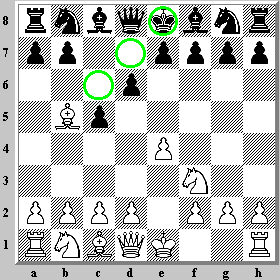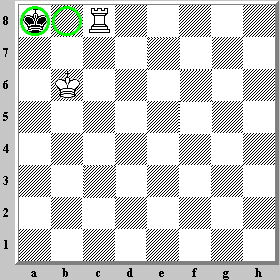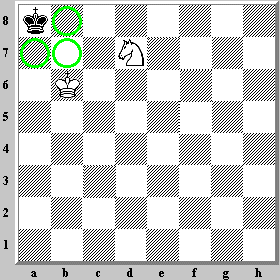|
|
During a normal game of chess, a player attacks the opponent's pieces many times. Usually the opponent will beat off the attack by moving the attacked piece, by capturing the attacker, or by intersecting the line of the attack. Sometimes a player will ignore an attack on a piece when, for example, there is a counterattack of greater value.
There is one attack that can never be ignored -- an attack on the King. Simply put, you can't leave your King under attack. If you have no way of escaping the attack, you lose the game.
|
|
Check

In this diagram the white Bishop is attacking the black King. The technical term for this is 'check'. We say that the Bishop is checking the King or that the King is in check.
Now Black must get out of check. This can't be done by moving the King -- the only free square is attacked by the same Bishop; or by capturing the Bishop -- none of Black's pieces attack that piece; which leaves only the possibility of intersecting the line of attack. Black must block the attack with a Knight, a Bishop, or a Queen.
Another consequence of this rule is that a player is not allowed to make a move which leaves the King in check. If this happens, the move has to be taken back.
|
|
Checkmate

Here the white Rook is attacking the black King. The King can't move -- all the surrounding squares are attacked by a white piece; there are no other pieces available to capture the Rook; and there are no pieces to intersect the line of attack. Black can't get out of check, so it's 'checkmate'. The game is won for White; it's 1-0.
Note that the checkmated King is never captured. The game simply ends at the point where the checkmate is recognized.
Click here to see some simple examples of checkmate or
here to see some of the most common checkmate patterns.
|
|
Stalemate

This diagram is similar to the previous diagram. All of the squares to which the King might move, as marked by the green circles, are under attack by one of the White pieces. Unlike the previous diagram, the King is not under attack. This situation, where a player has no legal moves and is not in check, is called 'stalemate'. The game is a draw; each player gets 1/2 point.
One obvious consequence of the checkmate rule is that the two Kings can never be on adjacent squares. That would leave both under attack.
|
Previous Page
--
Return to first page
Back to Introduction to the Rules
|

